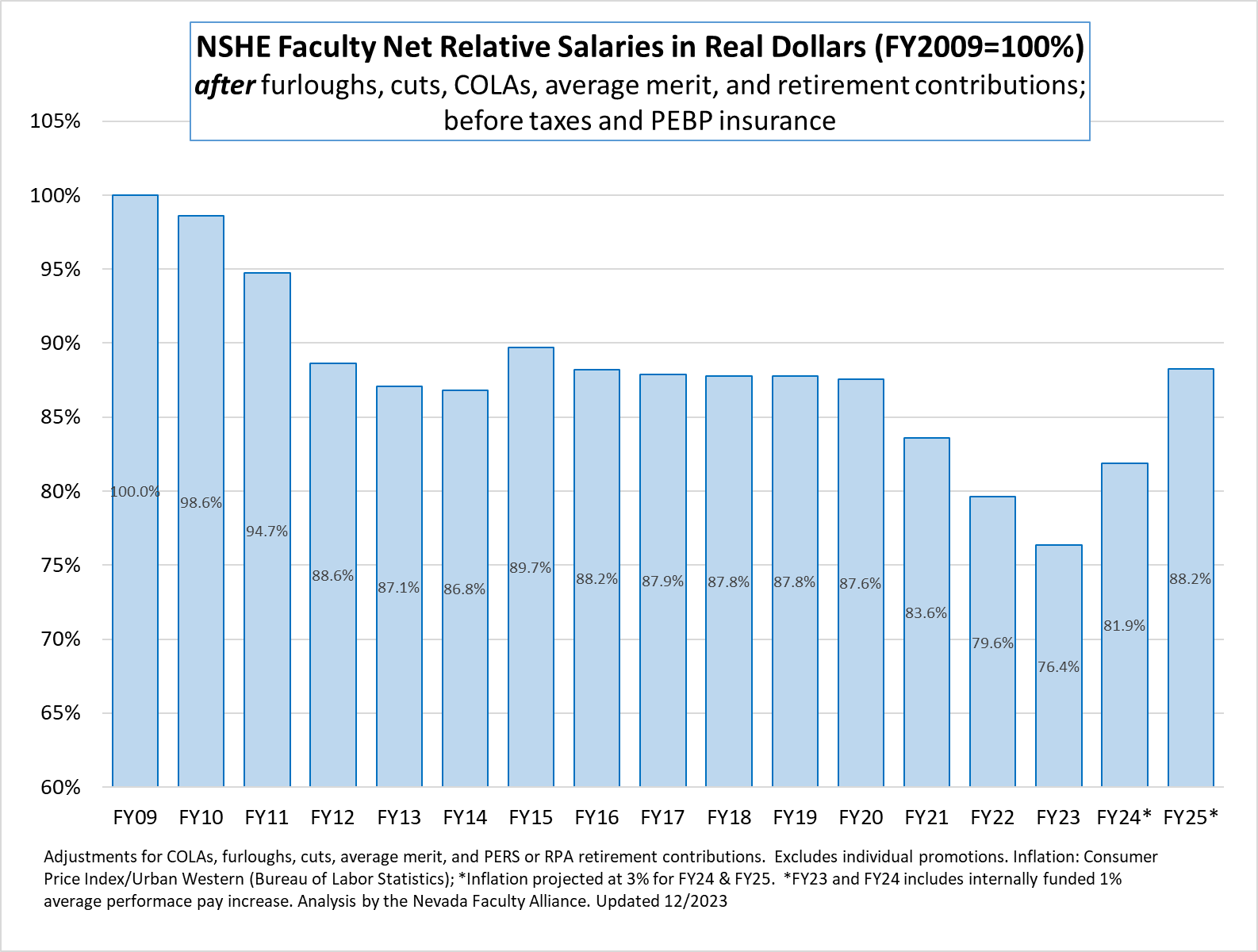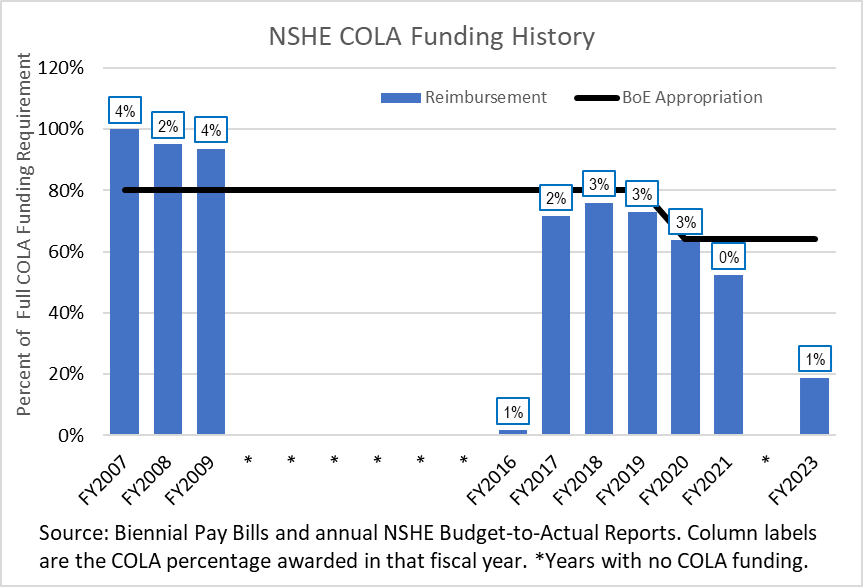UNR Budget: Misplaced Priorities and Diverted Resources
Underfunded COLAs for Classified and Professional Staff
Part 7 in our series on the University of Nevada, Reno, budget crisis. This installment reviews the funding of Cost of Living Adjustments for NSHE classified and professional employees.
The 12% + 11% Cost of Living Adjustments (COLAs) for state employees for 2023-2025 passed by the Legislature and signed by the Governor are historic. The NFA strongly advocated for the COLAs. We are grateful to the Regents for approving the full percentages for faculty and to student leaders for supporting the COLAs at the Board of Regents meeting on December 1. These COLAs will go a long way toward faculty retention, although the following chart shows that the COLAs still only bring take-home pay back to FY2020 levels after inflation.

President Sandoval has attributed “freezing around 100 vacant positions on campus, along with 5 percent budget reductions for each department on campus” to the Legislature underfunding faculty and staff COLAs. In this article, we counter the narrative that COLAs for faculty and staff are responsible for the budget shortfall. As described in our previous articles in this series, the new commitments of the current administration include athletics, executive positions and salary increases, and the Business Building project. Although the underfunded COLAs are a contributing factor, diversions of resources to the UNR administration’s priorities other than the core instructional mission have resulted in significantly larger budget impacts than the COLAs.
NSHE’s History of COLA Funding
When the state has funded COLAs, it has appropriated 80% of the budgetary cost [1], the premise being that less than 100% is needed due to regular employee turnover and vacancies. Eighty percent has averaged out in the past, as some agencies have been able to justify more funding than others. However, the procedures for justifying reimbursement are determined by the Governor’s Finance Office and have varied over time.
The following chart [2,3] shows how, in the three years prior to the Great Recession (FY2007–FY2009), NSHE was able to justify and was reimbursed for 93% to 100% of the required amounts, that is, more than the 80% appropriation to the Board of Examiners and essentially fully funding the COLAs.

No COLAs were provided for state employees from FY2010 to FY 2015, an era of furloughs and salary reductions. When COLAs were awarded from FY2016 to FY2019, the reimbursement rates to NSHE were variable, from 2% to 76%. That is, a COLA appropriation in the pay bill did not guarantee actual funding and the 80% appropriation appeared to be a cap on reimbursements to NSHE.
Before 2019, the 80% rule was applied to all NSHE personnel on the state-supported operating budgets, including the portion funded by student fees. Then, at the very end of the 2019 session, the appropriation for NSHE in the pay bill was only 64%, which reliable sources say was a math error, with 80% applied twice. Despite NSHE and NFA protests, the Legislature only appropriated the 64%. That percentage coincidentally approximately matched the fraction of the NSHE state-supported budget funded by state appropriations, the remainder being mostly student fees and tuition.
In the 2021 legislative session, the Legislature created a new budget policy (AB493, Sec. 7.3) whereby COLAs for NSHE budgets would be funded only for the portion of the budgets funded by state appropriations, that is, about 63% for NSHE overall but varying for each institutional budget and the non-formula budgets. For the 1% COLA in FY2023, NSHE overall was reimbursed for only 29% of the amount appropriated in the 2021 pay bill, or roughly 18% of the overall cost.
The 2023 Legislature retained the policy of funding NSHE COLAs only for the state-funded portion of budgets (AB522, Sec. 7.7). The Legislature funded NSHE COLAs at 65%, despite revenue surpluses and a budget amendment submitted by the Governor’s Finance Office that would have restored the 80% policy. With the historic COLAs of 12% on July 1, 2023, and 11% on July 1, 2024, the budget shortfall is larger and more difficult to absorb through regular vacancies and turnover.
This history shows that over the years the state has become increasingly stingier with funding COLAs for NSHE classified and professional staff, and now the state only funds COLAs for the state-funded portion of NSHE budgets. Since the only other source of COLA funding in the state-supported operating budget is revenue from student fees and tuition, that implies that the Legislature must expect COLAs to be proportionally funded by student revenue.
UNR’s COLA Funding for 2023-2025
UNR has a lower proportion of state appropriation (about 61%) than other NSHE institutions due in part to historically higher out-of-state student tuition (although revenue from non-resident students has decreased recently). For the state-supported UNR budgets, the difference between 100% funding of COLAs and the 61% funded for UNR by the Legislature in AB522 is $10.7 million in FY2024 and $21.7 million in FY2025, based on the data presented to the Board of Regents in June 2023 as updated by CFO Andrew Clinger to the Faculty Senate in November 2023. Roughly 85% of the COLA cost is for faculty and 15% for classified staff.
In the AB522 pay bill in 2023, the Legislature gave leeway to the Board of Regents to give faculty COLAs lower than the 12% in FY2024 and 11% in FY2025 that all other state employees are receiving. However, the Board of Regents approved the full 12% COLA for faculty in FY2024 at its June 30, 2023, meeting and approved COLAs for FY2025 at its December 1, 2023 meeting, with the following budget mitigations (Option A):
1) Delaying faculty’s 11% COLAs from July 1 to October 1, 2023, which is projected to save UNR $5.7 million in FY2025.
2) Raising student registration fees by 5% overall, with 15% of that amount being diverted to student access (financial aid) and 85% to the state operating budget, which is projected to raise $4.6 million for UNR in FY2025.
3) Suspending faculty performance pay increases for FY2025, which eliminates the 1% merit pool expense. Based on the FY2025 state-supported operating budget for UNR professional salaries of $144.9 million, that saves about $1.4 million.
In addition, only 11/12 of the faculty COLA increments and 23/24 of the classified COLA increments need to be paid in the first fiscal year because the final monthly or semimonthly pay period in June is paid in July of the next fiscal year. These budget savings were apparently not included in NSHE’s COLA calculations. Using the COLA figures from NSHE, this means the costs for professional and classified COLAs are $1.79 million and $1.83 million less than projected in FY2024 and FY2025, respectively.
After these mitigations and savings, the net cost of COLAs for UNR state-supported budgets is $8.9 million for FY2024 and $8.2 million for FY2025, including both faculty and classified staff. That is compared with the new continuing commitments by the UNR administration to other priorities such as athletics ($10+ million/year), executive positions and salary increases ($4.5 million/year), the Business Building project ($10.25 million/year), and iPads ($3.5 million/year). The diversion of resources to these uses are larger and prevent some unrestricted funds from being used for core academic programs. Thus, the narrative that underfunded COLAs are the only or primary driver for freezing 100 positions and the 5% budget cuts to departments is false.
The ongoing net underfunded cost of the COLAs for the UNR state operating budget is about $17 million per year (after the permanent 5% increase in student registration fees). COLAs are normally built into the salaries for the base budget for the next budget cycle but likely will only be funded by the state with the 65%/35% split between the general fund and student fees and tuition. Therefore, NSHE institutions must plan ahead for funding these and future COLAs in the budget development process. NSHE Committee on Higher Education Funding recommendations could alter future funding mechanisms—a policy for sharing the cost of operations between state funds and student revenue would be desirable.
###
The information in this series of analyses of the UNR budget is based on public reports and records, interpreted as accurately as possible given uncertainties in the assumptions used for various reports. Corrections from authoritative sources are welcome. Contact: kent.ervin@nevadafacultyalliance.org.
______
[1] 2007 Fiscal Report, Fiscal Analysis Division, Legislative Counsel Bureau, (p. 105).
[2] NSHE Accountability and Budget-to-Actual Reports: 2007, 2008, 2009, 2010, 2011, 2012, 2013, 2014, 2015, 2016, 2017, 2018, 2019, 2020, 2021, 2022, 2023.
[3] Pay bills: AB577 (2005). SB575 (2007), SB433 (2009), AB489 (2015), AB517(2017), SB368 (2017), AB542 (2019), AB493 (2021), AB522 (2023).
Articles in this series: